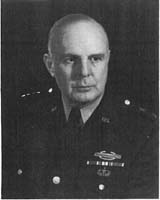Born on January 30, 1903 in South Carolina. This obituary for the NY Times best sums up Newman:NY TIMES OBITUARY:
Aubrey S. Newman, 90, Colonel Famed for 'Follow Me!' Battle Cry
Jan. 22, 1994
Aubrey S. Newman, the infantry colonel whose World War II battle cry of "Follow me!" became a watchword for infantry leadership and bravery, died here on Wednesday. He was 90 and had lived in Sarasota since 1960.
Colonel Newman shouted the words while commanding a regiment leading Gen. Douglas MacArthur's "return" to the Philippines on Oct. 20, 1944 -- an amphibious assault on Leyte island.
As the beach landing stalled, his men became pinned down by Japanese fire. To save them, he rose and gave his now-famous command. The men then swept forward against the Japanese defenders.
The cry became the motto of the 24th Infantry Division, and the Army depicted the incident on a recruiting poster that read: "Get up and get moving! Follow me!" Recipient of Medal
The action earned Colonel Newman a Distinguished Service Cross. Later in the campaign, in which his outfit fought for 77 days, he was wounded in the stomach.
His injury kept him out of action for the rest of World War II. But from 1945 until his retirement, he served in a number of high-level military positions, commanding airborne troops and serving as deputy commanding general of the Army Infantry Center, as chief of staff of the Iceland Defense Force and as chief of staff of the Army Continental Command.
His ability to earn the loyalty of his men and his beliefs about leadership were outlined in three books that he wrote after retirement.
The first, "Follow Me," was used as a teaching tool at the Army Command and General Staff College. His other works were "What Are Generals Made Of?" and "Follow Me II." He also wrote a column, "The Forward Edge," for Army magazine.
Born in Clemson, S.C., he began his military career as a second lieutenant assigned to the 29th Infantry at Fort Benning, Ga. He retired from the Army in 1960 as a major general.

PRIVATE CITIZENS SUPPORTING AMERICA'S HERITAGE
American
War Memorials Overseas, Inc.
War Memorials Overseas, Inc.
Newman Aubrey Strode “Red”
Name:
Aubrey Strode “Red” Newman
Rank:
Major General
Serial Number:
Unit:
34th Infantry Regiment, 24th Infantry Division
Date of Death:
1994-01-19
State:
South Carolina
Cemetery:
United States Military Academy Post Cemetery West Point
Plot:
Row:
Grave:
Decoration:
Comments:
